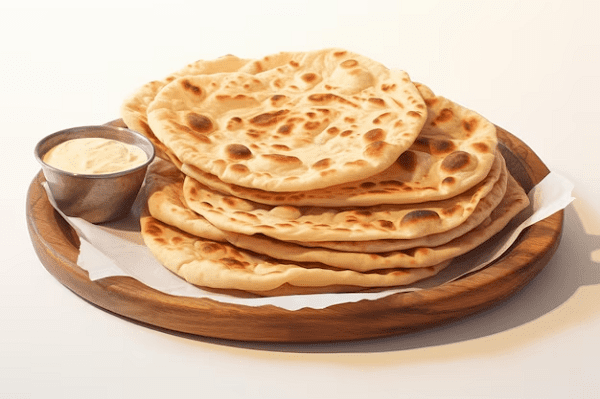Indian breads – 10 varieties- India is known for its rich culinary tradition, and bread is a significant part of Indian cuisine. Here are 10 popular varieties of Indian bread:
- Roti/Chapati:
- Description: Unleavened flatbread made from whole wheat flour.
- Serving: A staple in most Indian households, served with various curries and vegetables.
- Naan:
- Description: A leavened, oven-baked flatbread made with all-purpose flour and yogurt.
- Serving: Often served with rich gravies, kebabs, or tandoori dishes.
- Paratha:
- Description: Layered and flaky flatbread made from whole wheat flour and ghee (clarified butter).
- Serving: Can be stuffed with various fillings like potatoes, paneer (Indian cottage cheese), or spinach.
- Bhatura:
- Description: Deep-fried bread made from fermented dough, typically served with chickpea curry (chole).
- Serving: A popular choice for festive occasions and special meals.
- Puri:
- Description: Small, round, deep-fried bread made from unleavened wheat flour dough.
- Serving: Commonly served with potato curry (aloo sabzi) or sweet dishes.
- Kulcha:
- Description: Leavened flatbread, similar to naan, often stuffed with ingredients like mashed potatoes.
- Serving: Paired with chole (chickpea curry) or other gravies.
- Tandoori Roti:
- Description: Unleavened flatbread cooked in a tandoor (clay oven).
- Serving: Goes well with various vegetarian and non-vegetarian dishes.
- Missi Roti:
- Description: Flatbread made from a mixture of whole wheat flour and gram flour (besan).
- Serving: Known for its distinctive taste, often served with yogurt or pickles.
- Aloo Paratha:
- Description: Paratha stuffed with a filling of spiced mashed potatoes.
- Serving: Typically enjoyed with yogurt, butter, or pickles.
- Rumali Roti:
- Description: Thin, soft flatbread, resembling a handkerchief, made from unleavened wheat flour dough.
- Serving: Ideal for pairing with kebabs and other grilled dishes.
These are just a few examples, and there are many regional variations and specialties across India, reflecting the diverse culinary traditions of the country.
What is Indian breads – 10 varieties
Indian cuisine boasts a rich variety of breads, each with its own unique taste, texture, and preparation method. Here are 10 popular types of Indian bread:
- Roti/Chapati:
- Description: Unleavened flatbread made from whole wheat flour.
- Serving: A staple in Indian households, often served with curries and vegetables.
- Naan:
- Description: Leavened, oven-baked flatbread made with all-purpose flour and yogurt.
- Serving: Typically enjoyed with gravies, kebabs, or tandoori dishes.
- Paratha:
- Description: Layered and flaky flatbread made from whole wheat flour and ghee (clarified butter).
- Serving: Can be stuffed with various fillings like potatoes, paneer (Indian cottage cheese), or spinach.
- Bhatura:
- Description: Deep-fried bread made from fermented dough, usually served with chickpea curry (chole).
- Serving: Commonly eaten during festive occasions.
- Puri:
- Description: Small, round, deep-fried bread made from unleavened wheat flour dough.
- Serving: Typically paired with potato curry (aloo sabzi) or sweet dishes.
- Kulcha:
- Description: Leavened flatbread, often stuffed with ingredients like mashed potatoes.
- Serving: Goes well with chole (chickpea curry) or other gravies.
- Tandoori Roti:
- Description: Unleavened flatbread cooked in a tandoor (clay oven).
- Serving: Accompanies various vegetarian and non-vegetarian dishes.
- Missi Roti:
- Description: Flatbread made from a blend of whole wheat flour and gram flour (besan).
- Serving: Known for its distinctive taste, often served with yogurt or pickles.
- Aloo Paratha:
- Description: Paratha stuffed with spiced mashed potatoes.
- Serving: Typically enjoyed with yogurt, butter, or pickles.
- Rumali Roti:
- Description: Thin, soft flatbread, resembling a handkerchief, made from unleavened wheat flour dough.
- Serving: Ideal for pairing with kebabs and other grilled dishes.
These bread varieties represent a small fraction of the diverse Indian breadbasket, with different regions offering their own specialties and variations.
Who is Required Indian breads – 10 varieties
It seems like there might be a confusion in the wording of your question. If you’re asking about the origin or cultural significance of Indian bread varieties, they are traditional to Indian cuisine and have been part of the country’s culinary heritage for centuries. Indian breads are consumed by people of diverse backgrounds and are integral to various regional cuisines across India.
If you have a more specific question or if there’s a particular aspect you’d like more information about, please provide additional details, and I’ll do my best to assist you.
When is Required Indian breads – 10 varieties

If you’re asking about when Indian bread varieties are typically consumed or served, they are part of daily meals and can be enjoyed at various times of the day. The timing can depend on personal preferences, regional culinary traditions, and the specific type of bread. For example:
- Roti/Chapati: Often eaten with lunch or dinner.
- Naan: Commonly served with dinner, especially in restaurants.
- Paratha: Enjoyed for breakfast, lunch, or dinner. Stuffed parathas are versatile and can be eaten at any meal.
- Bhatura: Typically consumed during special occasions or festivals.
- Puri: Often served for breakfast or during festive meals.
- Kulcha: Paired with gravies for lunch or dinner.
- Tandoori Roti: Accompanies various dishes for lunch or dinner.
- Missi Roti: Enjoyed during meals, often paired with yogurt.
- Aloo Paratha: A popular choice for breakfast or brunch.
- Rumali Roti: Served with kebabs or gravies during lunch or dinner.
These bread varieties are diverse and can be adapted to different mealtime preferences. If your question was aimed at something else, please provide more details for clarification.
Where is Required Indian breads – 10 varieties
Indian breads, including the 10 varieties mentioned earlier, are commonly prepared and enjoyed across India. The availability and popularity of specific types of bread can vary by region due to local culinary traditions and preferences. Here’s a general overview:
- Roti/Chapati: Consumed throughout India, a staple in many households.
- Naan: Popular in North Indian cuisine but enjoyed throughout the country.
- Paratha: Eaten across India, with regional variations in stuffing.
- Bhatura: Commonly found in North Indian cuisine and enjoyed during special occasions.
- Puri: Consumed throughout India, especially during festivals and special occasions.
- Kulcha: Popular in North India, particularly in Punjab and Delhi.
- Tandoori Roti: Available in most regions, often associated with North Indian cuisine.
- Missi Roti: Enjoyed in North India, particularly in states like Punjab and Haryana.
- Aloo Paratha: Consumed throughout India, with variations in the filling.
- Rumali Roti: Originating from North India, commonly found in North Indian restaurants.
It’s important to note that these bread varieties are not confined to specific regions, and due to migration and cultural exchange, they are enjoyed throughout the country. Additionally, many Indian restaurants worldwide offer a diverse selection of Indian bread, allowing people from different parts of the world to experience these culinary delights.
How is Required Indian breads – 10 varieties
The preparation methods for Indian bread varieties can vary, and each type has its unique way of being made. Here’s a general overview of how some of the popular Indian breads are prepared:
- Roti/Chapati:
- Ingredients: Whole wheat flour, water.
- Method: Knead the dough, form small balls, roll them out, and cook on a griddle (tawa).
- Naan:
- Ingredients: All-purpose flour, yogurt, yeast, water, ghee.
- Method: Combine ingredients, knead, allow the dough to rise, shape into rounds, and cook in a tandoor or on a stovetop.
- Paratha:
- Ingredients: Whole wheat flour, water, ghee for layering.
- Method: Knead the dough, roll out, layer with ghee, fold, and cook on a griddle.
- Bhatura:
- Ingredients: All-purpose flour, yogurt, baking powder, water.
- Method: Mix ingredients, knead, allow the dough to rise, shape into balls, and deep-fry.
- Puri:
- Ingredients: Whole wheat flour, water.
- Method: Knead the dough, form small balls, roll them out, and deep-fry until they puff up.
- Kulcha:
- Ingredients: All-purpose flour, yogurt, baking powder, water.
- Method: Mix ingredients, knead, allow the dough to rise, shape into rounds, and cook in a tandoor or on a stovetop.
- Tandoori Roti:
- Ingredients: Whole wheat flour, water.
- Method: Knead the dough, shape into rounds, and cook in a tandoor or on a stovetop.
- Missi Roti:
- Ingredients: Whole wheat flour, gram flour (besan), spices, water.
- Method: Mix ingredients, knead, roll out, and cook on a griddle.
- Aloo Paratha:
- Ingredients: Whole wheat flour, mashed potatoes, spices, water.
- Method: Knead the dough, stuff with potato mixture, roll out, and cook on a griddle.
- Rumali Roti:
- Ingredients: All-purpose flour, water.
- Method: Knead the dough, roll out thinly, and cook on a griddle.
These are simplified overviews, and specific recipes can have additional ingredients or steps. The cooking process for each bread involves a combination of kneading, rolling, and cooking on a griddle or in a tandoor or deep-frying for some varieties.
Case Study on Indian breads – 10 varieties
Title: Exploring the Culinary Heritage
Introduction: Indian breads are an integral part of the country’s diverse and rich culinary landscape. This case study delves into the cultural significance, preparation methods, and regional variations of 10 popular Indian bread varieties, showcasing their importance in the Indian culinary tradition.
Objective: To provide insights into the historical, cultural, and gastronomic aspects of 10 distinct Indian breads and explore their role in different regions and occasions.
Methodology:
- Historical Context:
- Research historical records and culinary texts to understand the origins of each bread variety.
- Explore the evolution of these breads over time and their adaptation to different regional cuisines.
- Cultural Significance:
- Investigate the cultural importance of Indian breads in various regions.
- Analyze their role in festivals, celebrations, and everyday meals.
- Preparation Methods:
- Examine traditional recipes and preparation techniques for each bread variety.
- Highlight key ingredients, cooking methods, and variations in recipes across different regions.
- Regional Variations:
- Explore how each bread type varies in ingredients and preparation across different states and communities.
- Identify the unique regional twists and specialties associated with each variety.
Results:
- Roti/Chapati:
- Found throughout India, a symbol of daily sustenance.
- Prepared with whole wheat flour and served with a variety of curries and vegetables.
- Naan:
- Popular in North Indian cuisine, often paired with rich gravies and tandoori dishes.
- Leavened with yogurt and cooked in a tandoor for a distinctive texture.
- Paratha:
- A versatile bread, stuffed with various fillings like potatoes or paneer.
- Commonly enjoyed for breakfast or as a side dish with meals.
- Bhatura:
- Deep-fried and leavened, commonly served during festivals and special occasions.
- Paired with spicy chickpea curry (chole).
- Puri:
- Small, round, and deep-fried, a popular choice for breakfast or festive meals.
- Often served with potato curry (aloo sabzi) or sweets.
- Kulcha:
- Leavened bread, often stuffed and cooked in a tandoor.
- Popular in North India, especially in Punjab and Delhi.
- Tandoori Roti:
- Unleavened flatbread cooked in a tandoor, a staple in North Indian cuisine.
- Served with a variety of vegetarian and non-vegetarian dishes.
- Missi Roti:
- Made with a blend of whole wheat flour and gram flour (besan).
- Known for its distinctive taste and often served with yogurt or pickles.
- Aloo Paratha:
- Stuffed with spiced mashed potatoes, a favorite for breakfast or brunch.
- Served with yogurt, butter, or pickles.
- Rumali Roti:
- Thin, soft flatbread resembling a handkerchief, cooked on a griddle.
- Ideal for pairing with kebabs and other grilled dishes.
Conclusion: This case study illuminates the multifaceted nature of Indian breads, showcasing their historical roots, cultural significance, and diverse regional variations. From the everyday simplicity of roti to the festive indulgence of bhatura, these bread varieties encapsulate the essence of India’s culinary heritage, providing a delightful journey through its flavors and traditions.
White paper on Indian breads – 10 varieties
Executive Summary:
Indian cuisine is renowned for its diverse and vibrant flavors, and at the heart of this gastronomic tapestry are the various types of bread that grace tables across the country. This white paper explores the cultural, historical, and culinary dimensions of ten quintessential Indian bread varieties, shedding light on their significance and regional nuances.
I. Introduction: The Breadbasket of India
India’s love affair with bread is deeply rooted in its history, shaped by cultural practices, regional ingredients, and centuries-old traditions. This section provides an overview of the role bread plays in Indian cuisine and introduces the ten featured varieties.
II. Historical Perspectives: Tracing the Origins
Delving into the historical roots of each bread variety, this section aims to uncover the evolution of Indian bread-making techniques and their adaptation to diverse regional contexts.
III. Culinary Significance: Beyond Sustenance
Examining the cultural importance of Indian breads, this section explores how these varieties are woven into the fabric of everyday life, religious ceremonies, and festive celebrations.
IV. 10 Varieties in Focus: A Culinary Expedition
1. Roti/Chapati: The Everyday Emissary
- Describing the simplicity and ubiquity of roti as a staple in Indian households.
2. Naan: The Leavened Delight
- Unraveling the secrets behind the soft and flavorful naan, a favorite in North Indian cuisine.
3. Paratha: Layers of Love
- Exploring the versatility of paratha, with a focus on its stuffed variations and regional specialties.
4. Bhatura: Deep-Fried Festivity
- Unveiling the festive charm of bhatura, often enjoyed during special occasions.
5. Puri: Puffy Rounds of Pleasure
- Delving into the light and puffy puri, a delightful accompaniment to various dishes.
6. Kulcha: Stuffed and Savory
- Exploring the nuances of kulcha, a leavened bread often stuffed with flavorful ingredients.
7. Tandoori Roti: The Charcoal-Kissed Classic
- Describing the unique cooking method and flavor profile of tandoori roti.
8. Missi Roti: The Gram Flour Gem
- Showcasing the distinctive taste and nutritional benefits of missi roti.
9. Aloo Paratha: Spiced Potato Pleasure
- Celebrating the art of stuffing paratha with spiced mashed potatoes.
10. Rumali Roti: The Thin Veil of Indulgence – Describing the delicate and thin rumali roti, a perfect companion for kebabs.
V. Regional Variations: A Tapestry of Tastes
This section explores how each bread variety takes on unique regional characteristics, incorporating local ingredients and reflecting diverse culinary practices.
VI. Conclusion: A Flourishing Tradition
In conclusion, this white paper celebrates the rich tapestry of Indian breads, underscoring their significance in the nation’s culinary heritage. From the simple comfort of roti to the elaborate flavors of stuffed parathas, these bread varieties encapsulate the essence of India’s culinary diversity.
Acknowledgments: We extend gratitude to the culinary experts, historians, and regional cooks who generously shared their insights, making this exploration into the world of Indian breads possible.
Note: This white paper serves as a comprehensive guide and an appreciation of Indian bread varieties. Individual recipes and nutritional information can be found in specialized culinary resources.
Industrial Application of Indian breads – 10 varieties
While Indian bread varieties are traditionally associated with home cooking and street food, some of them also have industrial applications. Here’s a look at how some of the popular Indian breads are utilized in the food industry:
- Roti/Chapati:
- Application: Ready-to-Eat Meals
- Usage: Industrial production of packaged meals that include pre-cooked rotis, catering to busy lifestyles and the demand for convenient, quick meals.
- Naan:
- Application: Frozen Food Industry
- Usage: Mass production and distribution of frozen naan for consumers who want an authentic Indian bread experience without the effort of preparation.
- Paratha:
- Application: Institutional Catering
- Usage: Manufacture of bulk quantities of plain and stuffed parathas for use in catering services for schools, colleges, and corporate cafeterias.
- Bhatura:
- Application: Food Service Industry
- Usage: Production of pre-cooked bhaturas for use in restaurants and food service outlets, minimizing preparation time and ensuring consistency.
- Puri:
- Application: Snack Industry
- Usage: Manufacturing of packaged puris as ready-to-eat snacks, paired with various chutneys or dips for a quick and flavorful bite.
- Kulcha:
- Application: Fast Food Chains
- Usage: Large-scale production of kulchas for fast-food chains, offering a versatile bread option for different fillings and accompaniments.
- Tandoori Roti:
- Application: Catering and Events
- Usage: Production of tandoori rotis in large quantities for catering services and events, providing an authentic touch to large gatherings.
- Missi Roti:
- Application: Health Food Industry
- Usage: Manufacturing of packaged missi rotis as a healthier alternative, emphasizing the nutritional benefits of gram flour and whole wheat.
- Aloo Paratha:
- Application: Breakfast Products
- Usage: Production of frozen or pre-packaged aloo parathas for the breakfast food market, appealing to consumers looking for a convenient morning meal.
- Rumali Roti:
- Application: Fine Dining and Hospitality
- Usage: Production of thin and delicate rumali rotis for high-end restaurants and the hospitality industry, where they are often served with elaborate dishes.
Common Industrial Processes:
- Mass Production: Automated machinery is often employed for large-scale production, ensuring uniformity and efficiency.
- Freezing Technology: Many varieties, especially those meant for export or long shelf life, are processed and frozen for preservation.
- Packaging: Vacuum-sealed or airtight packaging is used to maintain freshness and increase the shelf life of the products.
These industrial applications not only cater to the growing demand for Indian bread varieties but also make these traditional foods more accessible to a global audience with diverse preferences and time constraints.





